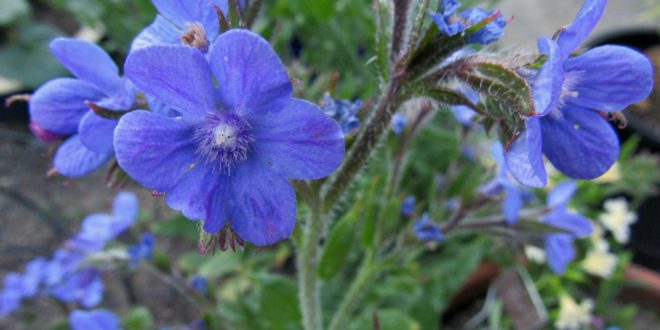Alkanet is one of our favorite flowers for late-spring and summer. It is covered with hundreds of deep blue to violet flowers reminiscent of forget-me-nots (Myosotis). It is a magnet for hummingbirds, butterflies, and several types of bees.
It is native to the Mediterranean but has been introduced in North America where it has escaped gardens and naturalized in British Columbia plus a number of States in the U.S.
We purchased our Alkanet plant from Yamagami Nursery in San Jose.
Our Alkanet is the Dropmore cultivar first commercially available in 1905. Anchusa azurea ‘Dropmore’, also known as alkanet or Italian bugloss, is a coarse, hairy, spring-blooming, clump-forming, short-lived perennial of the borage family that typically grows to 3-5’ tall.
The genus name comes from the Greek word ankousa in reference to a root pigment which was once used as a cosmetic paint for staining the skin. Specific epithet comes from the Latin word azureus meaning sky blue in reference to flower color.
Alkanet is a red dye made from the roots of some plants in the genus Anchusa.
Culture
Alkanet is easily grown in average, medium moisture, well-drained soils in full sun. Needs excellent drainage, but avoid dry soils. Loves deep, rich, fertile soils, but is more invasive therein and tends to grow taller and flop more. Taller plants do best with some form of staking or support. Can be short-lived in the garden. Prompt deadheading of spent flowers may prolong the bloom period and will help prevent any unwanted self-seeding. If foliage turns unsightly in summer after bloom, plants may be cut back hard to just a few inches tall. Plants may also be cut back hard in early autumn to aid in overwintering. Plants may be propagated by seed, division in spring or root cuttings. May readily self-seed (sometimes aggressively) and naturalize in the garden in optimum growing conditions, but cultivars of this plant generally do not come true from seed and should be propagated by root cuttings.
- Anchusa ‘Dropmore’
- Common Name: blue bugloss
- Type: Herbaceous perennial
- Family: Boraginaceae
- Zone: 3 to 8
- Height: 3.00 to 4.00 feet
- Spread: 1.50 to 2.00 feet
- Bloom Time: May to June
- Bloom Description: Deep blue
- Sun: Full sun
- Water: Medium
- Maintenance: Medium
- Suggested Use: Naturalize
- Flower: Showy, Good Cut
- Tolerate: Drought
- ‘Dropmore’ is best propagated by root cuttings taken in fall.
Problems
Crown rot can be a significant problem, particularly in wet, poorly drained soils. Taller plants usually need some kind of unobtrusive staking or support. Plant stems tend to open up and flop and foliage tends to depreciate in summer after bloom, particularly in hot and humid summer climates such as the St. Louis area.
Garden Uses
Borders. Specimen or small groups. Naturalized areas.








